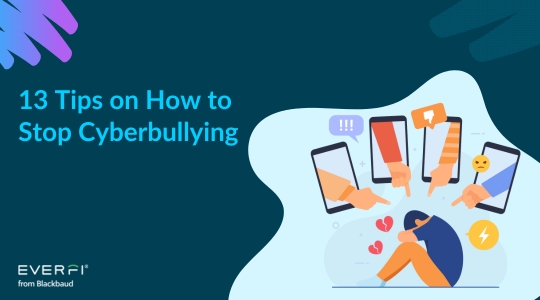Stopping Cyberbullying: Tips for Teens, Parents, & Teachers


According to award-winning school psychologist and author Dr. Kenneth Shore, “Cyberbullying is a new and growing form of bullying that has emerged with the advent of technology. It involves sending offensive, humiliating, or threatening messages or images through a computer or cell phone.”
While bullying is (sadly) common among older elementary school students, middle school students, and high school students, technology provides perpetrators with the advantage of hiding behind a screen, and/or anonymity. This means that one child can threaten, harass, or otherwise bully another without facing consequences for their actions.
According to the Pew Research Center, 46% of teens report that they’ve been harassed, bullied, or otherwise threatened online. Cyberbullying can threaten both physical and digital safety and can lead to devastating consequences when left unchecked. Here, we’ll explore how students, parents, and teachers can all do their part to stop cyberbullying in the United States.
Many students feel nervous about reporting cyberbullying, especially if they’ve encouraged the perpetrator or otherwise participated in cyberbullying themselves. Others may be nervous about the social consequences that could come with reporting a cyberbully. This means that it’s important for educators, parents, and students themselves to keep an eye out for kids who are exhibiting the negative effects of cyberbullying.
Common signs of cyberbullying include:
If you’re being cyberbullied, it can be hard to figure out what to do. You may worry that you’ll be judged by your peers or your own online activity will be scrutinized. No matter what has happened in the past, cyberbullying is never OK. Life will not be this way forever, and there are steps that you can take to put a stop to the bullying.
If you’re being bullied online, cutting off the bully by blocking them can stop the problem at the source. If another student is targeting you, blocking them can cut off their access to you, which can help eliminate the problem. While this can be an effective method in some cases, it can be harder when cyberbullying becomes complex.
According to the Child Mind Institute, “Until recently, parents, teachers, and news accounts have focused on the relationship between a bully and their target. But experts say that there are usually more kids involved in a cyberbullying scenario, making it a much more complex organism than previously thought. In fact, one of the side effects of how public bullying has become is that potentially everyone in the bully’s circle of friends — both online and offline — may be involved.”
This means that sometimes, blocking the perpetrator may not be effective, and you may need to take further action.
Talking to a trusted adult — like a parent, teacher, coach, or counselor — isn’t taking the easy way out. Left unchecked, cyberbullying can have severe consequences for both the victim and the perpetrator. When you ask for help, you’re showing your bully that you’re willing to stand up for yourself. You may find that it’s helpful to show your trusted adult screenshots or printouts of conversations and messages to help you explain what’s happening behind your screen.
Reporting a bully can feel scary, but doing so is often necessary to force the perpetrator to change their behavior. If you’re being bullied in an app, click on the safety settings. It’s likely that they’ll offer a way to report cyberbullying or will provide you with information on how to change your settings to lower the likelihood that the perpetrator can contact you. If bullying continues, you may need to talk with school administrators and/or law enforcement (especially if the bullying contains threats to your physical safety).
As a parent, it can be tough to get the real story on what’s happening on social media, in text conversations, and on gaming platforms. According to recent research, just 10% of students who experience cyberbullying report the issue to a parent or teacher. Keeping an open dialogue with your child can help them feel comfortable coming to you in the event that a bullying issue arises. It’s one of the key strategies in learning how to stop cyberbullying.
Talking to kids directly about their interactions on TikTok, Instagram, Reddit, and other social media and communication platforms can help them understand that they can come to you if there’s a problem. According to Dr. Meline Kevorkian, board member of the International Bullying Prevention Association, it’s also important to ask questions about their virtual activities just as you would their other activities. “Monitor their virtual friendships with questions you would ask about their friends in the physical world,” she recommends.
Giving your child your undivided attention shows that you care, you’re listening, and you’re on their team. Active listening is a skill, however, and it can take some time to get it right. When your child knows that you listen when they come to you, they’re more likely to feel comfortable speaking up when they experience a problem.
Try these tips to show your child that you’re actively listening to what they have to say:
Teachers are often the first line of defense against cyberbullying. From whispers in the hall to a devastated look on the face of a student who just not-so-secretly looked at her phone under her desk, educators have a front-row seat to the ups and downs of school social interactions.
Sometimes, it can take a little creative effort to learn more about what’s going on behind the screens of students.
Diane Kingston, a 6th-grade teacher in Omaha, NE, developed a strategy that helps students report bullying. Each week, Mrs. Kingston provides all students with a quarter sheet of paper. They write anything they’d like to share with her privately. She asks students who have nothing to say to write the Pledge of Allegiance, creating an environment where every student is writing quietly. Students fold their papers when they’re finished. After students have left for the day, Mrs. Kingston reads each paper, allowing her to keep her finger on the pulse of her classroom while providing students with a simple, private, no-pressure way to communicate bullying and other issues.
Let’s take a look at some other strategies educators can use to prevent cyberbullying.
Keeping an eye out for signs of bullying helps educators address incidents quickly before the situation reaches a tipping point.
According to the District of Columbia Public Schools, common signs of cyberbullying observed by educators include:
Often, students who are being bullied are afraid to come forward. This can especially be true for students who are bystanders to cyberbullying. When a student is aware that cyberbullying is happening, they may be hesitant to speak up due to fear of being ostracized from their friend group, getting a friend in trouble, or being seen as a snitch or a tattletale.
Conducting regular anonymous surveys can alert educators to potential cyberbullying issues that require further investigation. Teachers can also keep an eye out for trends using anonymous surveys that can help shape future lessons and conversations around appropriate online behavior.
Teaching students about staying safe on social media can help reduce the incidences of cyberbullying in a classroom or school. Hiding behind a screen can make it easy for perpetrators to forget that their actions may eventually catch up to them, potentially affecting their chances for future academic and career success.
Helping students become aware of the potential ramifications of cyberbullying can help put a stop to the behavior, according to Dr. Nicole Beurkens, a Michigan-based child psychologist. “Have a clear conversation about the consequences for cyberbullying,” she recommends. “Many teens are shocked to learn that their actions can cause them to wind up in court, or worse. While this should not be used to scare them, it is critical to educate them on the very real consequences of their online choices.”
Sometimes, education can help students realize that they have cyberbullied another student. In the event that a student comes forward to discuss what they’ve done wrong, it’s important to listen without judgment. Help the student develop a plan for moving forward, including a (supervised, if necessary) apology to the affected victim(s).
Any child can become a cyberbully. Easy access to the internet, the false sense of security caused by the anonymity of texting and social media, and the need for attention and/or validation can all push a student to become a cyberbully.
Certain factors may make a child more likely to become a cyberbully, including:
Thankfully, there are many steps that educators and parents can take to deter students from becoming cyberbullies. Proactive measures are key when it comes to learning how to stop cyberbullying.
Some steps that parents and teachers can take to prevent students from becoming cyberbullies include:
At EVERFI, we’re here to help learners of all ages maximize their potential with accessible education. We offer a wide range of free courses for educators, including character building & mental health lessons to help you teach students about social media and relationships, and more.
Teachers: Get started in under 15 minutes.
Administrators: Learn how you you can bring EVERFI’s free resources to your schools.

Author Bio: Amanda Berkey is a Pennsylvania-based writer and reporter with an M.S.Ed. in School and Mental Health Counseling. With 17 years of experience in education, she has taken on diverse roles in teaching, coaching, and administration.
Thanks to partners, we provide our digital platform, training, and support at no cost.
See why 21K schools use EVERFI.
Get access to free mental health lessons to help students develop feelings of self-efficacy and skills that promote and model advocacy for self and others.
Mental Health Awareness Toolkit
Prevention Toolkit
Financial Literacy Toolkit
Career Development Toolkit
Black History Toolkit
Scholarship Toolkit
Everfi uses anonymous data provided by cookies to improve site navigation, analyze site usage, and assist in our marketing efforts. Click to accept or choose your opt-out preferences.


